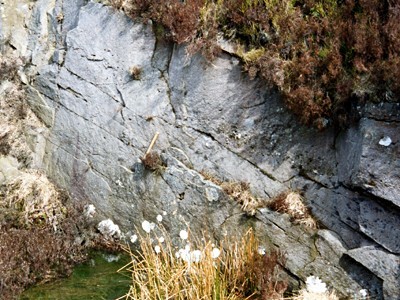Earth Science Conservation Review
| Carnmore Quarry | Fermanagh |
| Site Type: | Quarry (disused) |
| Site Status: | ASSI |
| Council area: | Fermanagh District Council |
| Grid Reference: | H475360 |
| Google maps: | 54.27109,-7.2709 |
| Rocks | |
|---|---|
| Rock Age: | Carboniferous (Asbian, Visean) |
| Rock Name: | Leitrim Group, Meenymore Formation |
| Rock Type: | Sand, Sandstone |
| Interest | |
| Minerals: | Dolomite, Quartz |
Summary of site:
This quarry provides the best section through a newly defined sandstone, the Carnmore Sandstone Member, within the Carboniferous Meenymore Formation.
In total, the sandstone is around 75m thick and, in the quarry, consists of pale grey to pale brown, medium to coarse grained sandstone with a sprinkling of quartz pebbles, some concentrated into thin, discontinuous beds. It is barely cemented but there are patches of iron oxide and a few layers of iron-rich dolomite, the latter weathering to an orange stain.
The angular grains show that the sands have not travelled far and the nature of the quartz pebbles indicates a metamorphic rock source. Ripple marks and cross stratification suggest relatively shallow water deposition. No obvious source area presents itself. The rock was formed in tropical conditions, around 337 million years ago.
The quality of this locality and its degree of exposure has resulted in its selection as the stratotype for the member (the standard of comparison for all other exposures of this rock). It must therefore be preserved.
The threats to the site are those common to all disused quarries, particularly land fill, dumping and overgrowth.
In total, the sandstone is around 75m thick and, in the quarry, consists of pale grey to pale brown, medium to coarse grained sandstone with a sprinkling of quartz pebbles, some concentrated into thin, discontinuous beds. It is barely cemented but there are patches of iron oxide and a few layers of iron-rich dolomite, the latter weathering to an orange stain.
The angular grains show that the sands have not travelled far and the nature of the quartz pebbles indicates a metamorphic rock source. Ripple marks and cross stratification suggest relatively shallow water deposition. No obvious source area presents itself. The rock was formed in tropical conditions, around 337 million years ago.
The quality of this locality and its degree of exposure has resulted in its selection as the stratotype for the member (the standard of comparison for all other exposures of this rock). It must therefore be preserved.
The threats to the site are those common to all disused quarries, particularly land fill, dumping and overgrowth.
| Enlander, I., Dempster, M. & Doughty, P., 2025. Carnmore Quarry, County Fermanagh, site summary. [In] Earth Science Conservation Review. https://www.habitas.org.uk/escr/summary.php?item=212. Accessed on 2025-04-03 |
| Previous Site | Next Site |
